- C# .NET
- Introduction to .NET Framework
- Applications of .NET, Before .NET
- .NET Advantages, .NET (vs) Java, .NET Framework in-depth
- .NET Framework Architecture, Assemblies and MSIL in-depth
- Run Time Execution Environment, Components of CLR, FCL Architecture
- Getting Started with Visual Studio , Visual Studio IDE
- C# Introduction
- Keywords, I/O Statements, Comments
- Data Types, Variables, Type Casting
- Object class methods, Scope of Variables, Operators, Control Statements
- Enumerations and Arrays
- Main() method in-depth
- Classes and Objects, Creating own classes
- Parameters and Method Overloading
- Properties
- Constructors and Destructors
- Structs
- Partial Classes and Static Classes
- Introduction to Inheritance, Visibility Modifiers and Simple Inheritance
- Hierarchical, Multi-Level and Hybrid Inheritance
- Hiding methods, Method Overriding, Abstract Classes and Methods
- Sealed Classes and Interfaces
- Delegates
- Array Class
- Strings
- DateTime and Random Classes
- Generics
- Collections
- LINQ
- Exceptions
- Debugging, Break points, Immediate window
- Multi Threading
- Multi Threading
- Assemblies
- Assemblies
- Manipulating Drives
- Manipulating Folders
- Manipulating Files and File Streams
- Application Configuration
Def: The process of implementing the "Parent-Child" relationship between two or more classes.
As a part of this "Inheritance" implementation, parent and child classes are to be implemented.
Advantage: All the data members and methods of the parent class are accessible by child class. This is called as “Re-usability”. That means the parent class members are re-usable in the child class.
The parent class can also be called as "Base" / "Super" class.
The child class can also be called as "Derived" / “Sub” class.
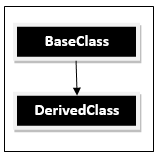
Classification of Inheritance supported by C#:
1) Implementation Inheritance:
This is commonly used inheritance.
Whenever a class is derived from another class, it can be called as “Implementation Inheritance”.
As said above, all of the members of the super class are adopted by sub class.
2) Interface Inheritance:
This type of inheritance is taken from “Java”.
Whenever a class is derived from an interface, it can be called as “Interface Inheritance”.
The interface is similar to the class, but doesn’t contain the method definitions; it contains the method declarations only.
We discuss about the interfaces in-depth later.
As a part of this "Inheritance" implementation, parent and child classes are to be implemented.
Advantage: All the data members and methods of the parent class are accessible by child class. This is called as “Re-usability”. That means the parent class members are re-usable in the child class.
The parent class can also be called as "Base" / "Super" class.
The child class can also be called as "Derived" / “Sub” class.

Classification of Inheritance supported by C#:
1) Implementation Inheritance:
This is commonly used inheritance.
Whenever a class is derived from another class, it can be called as “Implementation Inheritance”.
As said above, all of the members of the super class are adopted by sub class.
2) Interface Inheritance:
This type of inheritance is taken from “Java”.
Whenever a class is derived from an interface, it can be called as “Interface Inheritance”.
The interface is similar to the class, but doesn’t contain the method definitions; it contains the method declarations only.
We discuss about the interfaces in-depth later.
1) Single Inheritance
This is the simplest type of inheritance.
An inheritance relationship, with only one super class and one sub class.

2) Hierarchical Inheritance
An inheritance relationship, with only one super class and multiple sub classes.
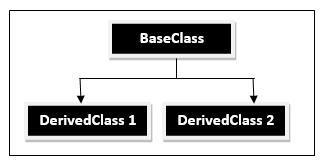
3) Multi-Level Inheritance
An inheritance relationship, with only one super class and multiple sub classes, and also extended with another sub class from the first sub class.
In other words, a class acts as super class and sub class simultaneously.
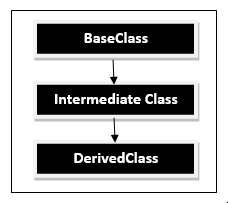
4) Multiple Inheritance
An inheritance relationship, with only multiple super classes and only one sub class.
“Multiple Implementation Inheritance” is not supported by C#, but “Multiple Interface Inheritance” is supported by C#.
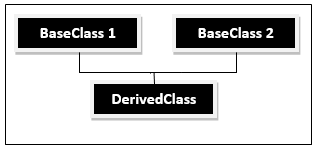
5) Hybrid Inheritance
An inheritance relationship that contains a combination of any other two types of inheritances.
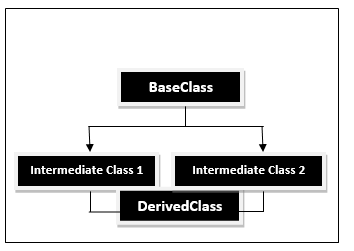
Ex:
Multiple + Hierarchical Inheritance
Multiple + Multi Level Inheritance etc.
Note: Other OOP languages like C++ support multiple inheritance. But C# and VB.NET doesn’t support multiple inheritance to avoid some practical problems while developing future GUI applications like windows forms applications, web sites etc.
But instead, C# and VB.NET supports “multiple interface inheritance”, because it doesn’t cause any practical problems.
Implementation steps for Inheritance
Define the super class
class superclassname
{
//data members of super class
//methods of super class
}
Define the sub class
class subclassname : superclassname
{
//data members of sub class
//methods of sub class
}
Construct the object for sub class
SubClass obj = new SubClass();
Invoke methods
obj.SuperClassMethod();
obj.SubClassMethod();
Example
We start with an example:
class A
{
void Hello()
{
Console.WriteLine(“Hello, World!”);
}
}
class B:A
{
void Hai()
{
Console.WriteLine(“Hai to all!”);
}
}
In the above example, we have two classes called “A” and “B”. The inheritance relationship has been established between these classes. Now, the “A” class is called as “Super” class and “B” class is called as “Sub” class. All the members of “A” class are exactly copied into “B” class. Finally, whenever you construct an object for the “B” class, you can access both “Hello()” method and “Hai()” method also from that object. This is what we learned up-to-now.
But sometimes, some of the super class members may not be accessible directly from the sub class’s object. This kind of nature depends on the “visibility modifiers”, we use in the super class, while we declare the super class members.
This is the simplest type of inheritance.
An inheritance relationship, with only one super class and one sub class.

2) Hierarchical Inheritance
An inheritance relationship, with only one super class and multiple sub classes.

3) Multi-Level Inheritance
An inheritance relationship, with only one super class and multiple sub classes, and also extended with another sub class from the first sub class.
In other words, a class acts as super class and sub class simultaneously.

4) Multiple Inheritance
An inheritance relationship, with only multiple super classes and only one sub class.
“Multiple Implementation Inheritance” is not supported by C#, but “Multiple Interface Inheritance” is supported by C#.

5) Hybrid Inheritance
An inheritance relationship that contains a combination of any other two types of inheritances.

Ex:
Multiple + Hierarchical Inheritance
Multiple + Multi Level Inheritance etc.
Note: Other OOP languages like C++ support multiple inheritance. But C# and VB.NET doesn’t support multiple inheritance to avoid some practical problems while developing future GUI applications like windows forms applications, web sites etc.
But instead, C# and VB.NET supports “multiple interface inheritance”, because it doesn’t cause any practical problems.
Implementation steps for Inheritance
Define the super class
class superclassname
{
//data members of super class
//methods of super class
}
Define the sub class
class subclassname : superclassname
{
//data members of sub class
//methods of sub class
}
Construct the object for sub class
SubClass obj = new SubClass();
Invoke methods
obj.SuperClassMethod();
obj.SubClassMethod();
Example
We start with an example:
class A
{
void Hello()
{
Console.WriteLine(“Hello, World!”);
}
}
class B:A
{
void Hai()
{
Console.WriteLine(“Hai to all!”);
}
}
In the above example, we have two classes called “A” and “B”. The inheritance relationship has been established between these classes. Now, the “A” class is called as “Super” class and “B” class is called as “Sub” class. All the members of “A” class are exactly copied into “B” class. Finally, whenever you construct an object for the “B” class, you can access both “Hello()” method and “Hai()” method also from that object. This is what we learned up-to-now.
But sometimes, some of the super class members may not be accessible directly from the sub class’s object. This kind of nature depends on the “visibility modifiers”, we use in the super class, while we declare the super class members.
C# supports the following visibility modifiers.
A simple demo on inheritance
using System;
using System.Collections.Generic;
using System.Linq;
using System.Text;
namespace SimpleInheritanceDemo
{
//super class
class Country
{
public void ShowCountry()
{
Console.WriteLine("This is India..");
}
}
//sub class
class State : Country
{
public void ShowState()
{
Console.WriteLine("This is Andhra Pradesh..");
}
}
class Program
{
static void Main(string[] args)
{
//create instance for sub class
State st = new State();
//access the members
st.ShowCountry();
st.ShowState();
Console.Read();
}
}
}

: Demo on “protected” modifier
using System;
using System.Collections.Generic;
using System.Linq;
using System.Text;
namespace SimpleInheritanceDemo
{
//super class
class Country
{
protected void ShowCountry()
{
Console.WriteLine("This is India..");
}
}
//sub class
class State : Country
{
public void ShowState()
{
ShowCountry();
Console.WriteLine("This is Andhra Pradesh..");
}
}
class Program
{
static void Main(string[] args)
{
//create instance for sub class
State st = new State();
//access the members
st.ShowState();
Console.Read();
}
}
}

| Sl. No | Visibility Modifier | Description |
| 1 | private | This is the default modifier. The item is visible only within the self class. |
| 2 | public | The item is visible in any other classes. It offers un-limited access to the item. |
| 3 | protected | The item is visible in the self class and in the derived classes. |
| 4 | internal | The item is visible anywhere in the current assembly only. |
A simple demo on inheritance
using System;
using System.Collections.Generic;
using System.Linq;
using System.Text;
namespace SimpleInheritanceDemo
{
//super class
class Country
{
public void ShowCountry()
{
Console.WriteLine("This is India..");
}
}
//sub class
class State : Country
{
public void ShowState()
{
Console.WriteLine("This is Andhra Pradesh..");
}
}
class Program
{
static void Main(string[] args)
{
//create instance for sub class
State st = new State();
//access the members
st.ShowCountry();
st.ShowState();
Console.Read();
}
}
}

: Demo on “protected” modifier
using System;
using System.Collections.Generic;
using System.Linq;
using System.Text;
namespace SimpleInheritanceDemo
{
//super class
class Country
{
protected void ShowCountry()
{
Console.WriteLine("This is India..");
}
}
//sub class
class State : Country
{
public void ShowState()
{
ShowCountry();
Console.WriteLine("This is Andhra Pradesh..");
}
}
class Program
{
static void Main(string[] args)
{
//create instance for sub class
State st = new State();
//access the members
st.ShowState();
Console.Read();
}
}
}
